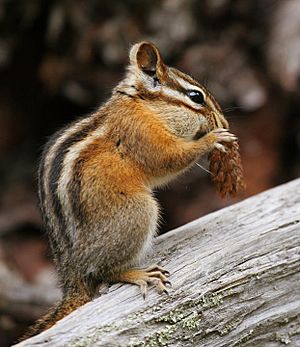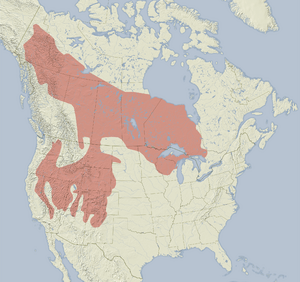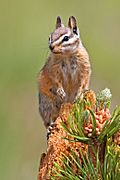Least chipmunk facts for kids
Quick facts for kids Least chipmunk |
|
|---|---|
 |
|
| Conservation status | |
| Scientific classification | |
| Genus: |
Neotamias
|
| Species: |
minimus
|
 |
|
| Distribution of the least chipmunk | |
| Synonyms | |
|
|
The least chipmunk (Neotamias minimus) is the smallest type of chipmunk. It is also the most common chipmunk found across North America.
Contents
What Does a Least Chipmunk Look Like?
This chipmunk is the tiniest of all chipmunk species. It measures about 15.7 to 25 centimeters (6 to 10 inches) long. It weighs between 25 and 66 grams (about 1 to 2 ounces).
Its body is gray to reddish-brown on the sides. Its belly is grayish-white. The back has five dark brown or black stripes. These stripes are separated by four white or cream-colored stripes. All these stripes run from its neck to the base of its tail.
The least chipmunk also has stripes on its face. Two light and two dark stripes run from its nose to its ears. Its bushy tail is orange-brown and is about 10 to 11 cm (4 inches) long.
It can be hard to tell the least chipmunk apart from the yellow-pine chipmunk. This is especially true in areas where both species live. Scientists sometimes need to study their bones to tell them apart.
Like other chipmunks, it has four toes on its front feet and five toes on its back feet. Female least chipmunks have eight teats, which are used for feeding their young.
Where Do Least Chipmunks Live?
Least chipmunks live across the western United States. You can find them from northern New Mexico to eastern California. They also live in Oregon and Washington.
In Canada, they are found throughout much of the south and west. This includes Yukon, British Columbia, and Ontario. They also live in parts of Michigan, Wisconsin, and Minnesota.
There are at least 21 different types, or subspecies, of least chipmunks. They live in many different places. They are often found in sagebrush areas and coniferous woodlands. They also live near rivers. You might also see them in high mountain meadows and at the edge of the northern tundra.
How Do Least Chipmunks Behave?
Least chipmunks are active during the day. This means they are diurnal. They eat seeds, berries, nuts, fruits, and insects. They mark areas where they have eaten all the good food with their urine. This helps them remember not to go back to those spots.
The area a chipmunk uses for food and shelter is called its home range. This area can be very different in size. It can be as small as 0.1 hectares (about 0.25 acres) in Michigan. It can be as large as 5.5 hectares (about 13.5 acres) in Colorado.
Because they are so small, least chipmunks are usually less dominant than yellow-pine chipmunks. Yellow-pine chipmunks can chase them away from food if there's plenty to go around. However, least chipmunks need less food to survive. This means they are more common in places where food is scarce.
These chipmunks are very quick and nimble. They have been seen running as fast as 7.7 kilometers per hour (about 4.8 miles per hour) in nature.
Who Are Their Predators?
Animals that hunt and eat least chipmunks include hawks, owls, and mustelids (like weasels).
Winter Habits and Burrows
Least chipmunks spend the winter in their burrows. They also hide food in many secret spots. These spots are often under logs or other cover.
Their burrows have one main room, about 15 cm (6 inches) wide. The tunnels are about 7.5 cm (3 inches) across. On average, the tunnels are 1.7 meters (about 5.5 feet) long. Burrows usually have two to four entrances. These entrances are often hidden by nearby rocks. They are typically about 18 cm (7 inches) below the ground.
During the summer, they might build temporary nests in trees. They make these nests from leaves and grass. They also use hollows made by woodpeckers.
Least chipmunks do not truly hibernate like some other animals. They also don't get extra fat in the fall. Instead, they go into a deep sleep called torpor for long periods during winter. They wake up to eat the food they stored in their burrow. How long they stay underground depends on where they live. It can be from late November to mid-March in Michigan. In northern Manitoba, it can be from mid-October to late April.
Reproduction and Life Cycle
Female least chipmunks are ready to mate within a week of coming out of their burrows in the spring. Mating usually happens between March and May.
Pregnancy lasts about 28 to 30 days. Females usually have one litter of three to seven babies each year. If a female loses her first litter soon after they are born, she might be able to have another litter in the same year.
The baby chipmunks are born without hair and cannot see. They are about 5 cm (2 inches) long and weigh about 6 grams (0.2 ounces). They can stand and open their eyes when they are 27 days old. They stop drinking their mother's milk at 36 days old.
Least chipmunks can have their own babies when they are one year old. However, they don't always breed until their second year. In zoos or special care, they can live for up to six years.
Gallery
See also
 In Spanish: Ardilla rayada para niños
In Spanish: Ardilla rayada para niños





